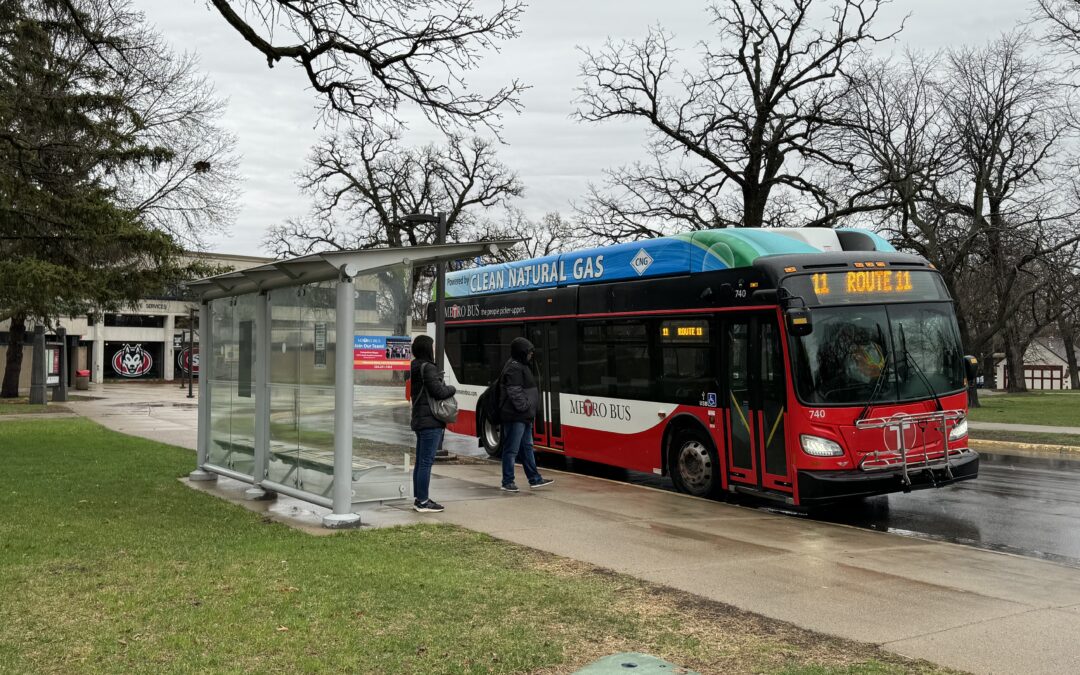Article Written by Mitchell Welker. Photo by Mitchell Welker.
Every day, hundreds of Huskies ride on Metro Bus. Some to get to class, then to get home, some to get groceries or to get to an appointment. Some ride because they don’t have a car, others ride despite having one. It flies under the radar in the extremely car-centric granite city, but in a world of growing disdain for traffic and an uptick in public transportation funding in the United States, it seemed to be on a good trajectory in recent years.
However, a certain global pandemic descended on St. Cloud in spring of 2020, and the metaphorical apple cart was overturned three times and set on fire. Multiple Metro Bus routes that specifically served a bustling campus were ended. Among those on the chopping block was Route 91, Husky Shuttle Day, which ferried students from K Lot (south of The Herb) up to the center of campus, around the Wick Science Building. Nowadays, K Lot sits unused along with the Husky Hub, a warming shelter.
So was Route 92, Husky Shuttle Night, which ran similarly from the southern tip of campus but continued further north to student housing areas and looped back. Route 93, the Sundowner, was dealt the same fate. It was a unique weeknight bus that would originally drop students off wherever they asked within a couple miles’ range of campus but ended as a designated fixed route.
When students stopped coming to campus, they stopped needing these special buses. These routes haven’t returned because the students haven’t returned. Although the student population has been steadily declining for over a decade according to SCSU factbooks, the majority of classes were still taking place on campus until the pandemic hit. Now, the majority is held by online and hybrid classes. College has changed, drastically. The loss of these services, among many others on campus, seem part of a very slow but potentially unstoppable rot of the fabled “college experience.”
SCSU’s specific routes weren’t the only ones impacted, of course. Metro Bus needed to cut back its service and frequency on its public fixed routes as well. It was a delicate task of continuing to provide as much service as possible with the number of employees available.
Now four years on from the pandemic’s onset, Dave Green, COO of the St. Cloud Metropolitan Transit Commission, says, “We’re essentially comparing ourselves to two different worlds.”
That is to say that trying to return to pre-pandemic ridership levels may be unreasonable or impossible within the foreseeable future. From 2019 to 2021, fixed route and commuter Metro Bus ridership dropped from 1,528,524 to 685,684 according to statistics from Green. They hit their lowest in 2022 with 608,903 people passing the fare gate.
Green remarked that work-from-home has been a big contributor to the drop in ridership across the country.
It took a pandemic for the United States to wake up and catch up with the rest of the world in regards to remote work, and obviously with that came less commuters and less fares being paid.
There’s also the fact that some still do not feel safe riding public transit anymore.
“We’re doing everything we can to make sure [our buses] are clean and safe for them to ride,” says Green, but the mental and psychological changes from lockdown and fear of illness still have some grasp.
However, Metro Bus isn’t willing to go down easy, and in fact, they’re beginning to rebound. In 2023, 636,504 fixed route and commuter fares were paid, up just a bit from 2022, but up nonetheless. Green remarked that Metro Bus is among the quickest-recovering transit authorities in the nation, and an outside consulting firm has been hired to fully assess St. Cloud’s residency and needs to determine how best to use Metro Bus’s assets.
“We’ve got some pretty exciting things coming up,” he said, and within 2-3 years they could be put into action.
Back on campus, SCSU students now make up a greater percentage of total Metro Bus ridership than they did before the pandemic, according to ridership stats from Green. In 2023, Huskies made up 7.9 percent of ridership, up from 5.8 percent in 2019. Routes 5, 8, 11, and 12 still operate regularly from campus and reach the Transit Center downtown (where riders can change to other routes) and all throughout St. Cloud. Although significantly less people are riding the bus in St. Cloud today, there remains a strong contingent of Husky riders that find great value in the service.
Among them is Ebube Ogbonna, a Mass Communications student who lives off campus. Although she says she has a car at her residence, she still takes the bus to campus and especially relies on it in the winter.
“Since I don’t live on campus and commute, I found it easier to not only have that transportation but avoid paying for on-campus parking if I used my personal vehicle,” she said when asked about her use case. “There’s options not to pay for parking, but it requires parking your personal vehicle further away by residences and it wasn’t a commute I was willing to walk in the cold.”
She’s just a few of the 7,699 fares “paid” by students in January 2024. “Paid”, in quotations, because SCSU students can board any bus without paying a fare by presenting their student ID. The “U-Pass Ride Program”, as it’s known, has existed for students since 2003, and even beginning in 1988 Metro Bus offered deeply-discounted fares to students, according to the Metro Bus website. It’s a longstanding, strong partnership that Huskies still rely on.
Each fare on Metro Bus ordinarily costs $1.25, but SCSU’s contracted rate for students is $0.90 per fare. The total cost is billed annually to SCSU and comes out to an average of $60,000 per year. That’s according to Dan Golombiecki, Associate Vice President of Finance and Administration at SCSU. The bill is paid in a 50/50 manner: half from student activity fees, which are assessed per credit taken for each student, and half from the “general fund”, or tuition fees. Although costs do eventually get shouldered by students, financial aid and the pay-in of every student keeps it more affordable and encourages using the bus to get value back out.
Some students may never step foot on Metro Bus, relying on their own set of wheels to get around. But for the Huskies that do need it daily, and for those who may need or want to use it someday, it’s wide-reaching, it’s paid for, and it’s consistent. Green’s stats say Metro Bus has 99% on-time performance. And it would be a safe bet that SCSU remains united with Metro Bus for 100% of its future.






Recent Comments